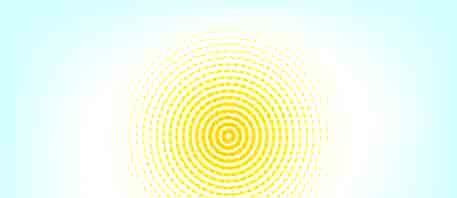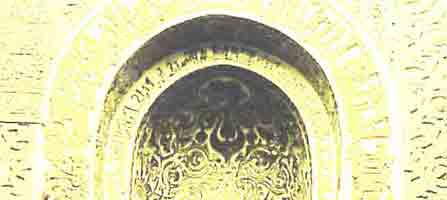
Edit OmarKN
bit.ly/_khyl
The Islamic concept of imagination (khayál ) comprises a vast area and is interconnected with every main idea of Islamic thought, but where words are only insufficient indicators. Therefore it is an important faculty, without which man will not be able to grasp anything beyond his rational faculty2, which is exactly the problem for many of us human beings today. Without Creative Imagination, symbolism cannot be understood.3
Imagination in the Islamic context "designates a reality or 'presence' that becomes manifest in” the cosmos4; in the macrocosm; and in the microcosm. It also designates in a narrower sense "the 'faculty of imagination,' considered as one of several faculties of the soul, along with reason, reflection, and memory.” 5
 The Imagination we are referring to here must not be confounded with fantasy, which Paracelsus already observed as an exercise of thought without foundation in nature, calling it the 'madman's cornerstone.' It does not 'create being'.
The gnostic conception of Imagination posits real being, far from an agnosticism pure and simple. 6
The Imagination we are referring to here must not be confounded with fantasy, which Paracelsus already observed as an exercise of thought without foundation in nature, calling it the 'madman's cornerstone.' It does not 'create being'.
The gnostic conception of Imagination posits real being, far from an agnosticism pure and simple. 6
This then is intimately linked to man's ability to create or to his 'creativity,' which of course always has to be understood as a metaphoric creativity in view of the Creativity by the Real.
”Unveiling is generally associated with Imagination, because it typically occurs through the imaginalization of various invisible entities or realities.” And "unveiling is an everyday occurrence for prophets. For the friends of God, it is an INHERITANCE from the prophets. The FOLK OF UNVEILING are the highest ranking friends of God.”7
 Things "that are normally inaccessible to sense perception or to reason are given form by God and then perceived within imagination by those to whom [some tiny rift toward] the unseen things has been opened.”8
Things "that are normally inaccessible to sense perception or to reason are given form by God and then perceived within imagination by those to whom [some tiny rift toward] the unseen things has been opened.”8
"Imagination is fundamentally an intermediary reality; as such it is intrinsically ambiguous … hence it is a barzakh par excellence.” 9

3.1
In the Quran and the hadith there are a few instances of khayál. The concept of khayál is used to refer both to the mental faculty of imagination and to the world as it manifests itself, as a kind of "imagination.” Ibn al-'Arabi explains it so:
"Imagination is neither existent nor non-existent, neither known nor unknown, neither negated nor affirmed. For example a person perceives his form in a mirror. He knows for certain that he has perceived his form in one respect and he knows for certain that he has not perceived his form in another respect. … He cannot deny that he has seen his form, and he knows that his form is not in the mirror, nor is it between himself and the mirror. …” 10
3.2
Sahl b. `Abd Allah al-Tustari
On verse 20-18 {I also have other uses for it} (for the staff):
Moses (Mosa - peace upon him) mentioned the benefits and uses of the staff that had appeared to him, but God, Exalted is He, intended (to draw his attention to) uses and benefits (of the staff) that were, as yet, hidden from him, such as its turning into a snake, or (Moses’) striking the rock with it so that the springs gushed forth from it, or his striking the sea with it, and other such uses. It was through this that He showed him that the knowledge of people, even when they are supported by prophecy (nubuwwa), is deficient when compared to God’s knowledge regarding the universe of created things.30
3.3
{ فَأَلْقَاهَا فَإِذَا هِيَ حَيَّةٌ تَسْعَىٰ } Sura 20-20
Moses was made to imagine, by their sorcery, that their ropes and staffs were sliding.
3.4
The example of Sulayman (pbuh) and Bilqīs, when her throne disappeared in one place and reappeared in Sulayman's palace. Then Bilqīs "recognized the impossibilty of a material transfer,”11 and exclaimed:12
{ فَلَمَّا جَاءَتْ قِيلَ أَهَٰكَذَا عَرْشُكِ قَالَتْ كَأَنَّهُ هُوَ وَأُوتِينَا الْعِلْمَ مِن قَبْلِهَا وَكُنَّا مُسْلِمِينَ }
{"Is your throne like this?" She said, "[It is] as though it was it."}
3.5
In this context, there is the word tamaththala (mithál ), which is not used for the imaginative faculty itself, but only for the objective world, as it presents itself to us.
As a synonym to "imagination”: tamaththala is to resemble, to look like, to imitate, to appear in the likeness of something. It is repeatedly used in the Quran and the hadith,
so for example in Sura Maryam, 19-17:13
{ فَاتَّخَذَتْ مِن دُونِهِمْ حِجَابًا فَأَرْسَلْنَا إِلَيْهَا رُوحَنَا فَتَمَثَّلَ لَهَا بَشَرًا سَوِيًّا }
{he represented himself to her as a well-proportioned man.} or:
{he became imaginalized to her as a man without fault.}
or in the hadith:
"Satan cannot become imaginalized (tamaththal ) in my image (mithl )” or "in my form.”14
مَنْ رَآنِي فِي الْمَنَامِ فَقَدْ رَآنِي، فَإِنَّ الشَّيْطَانَ لاَ يَتَخَيَّلُ بِي
"Whoever has seen me in a dream, then no doubt, he has seen me, for Satan cannot imitate my shape."31
3.6
Another example is the prophetic Gibril hadith:
الإِحْسَانُ أَنْ تَعْبُدَ اللَّهَ كَأَنَّكَ تَرَاهُ، فَإِنْ لَمْ تَكُنْ تَرَاهُ فَإِنَّهُ يَرَاكَ
The Prophet ﷺ said, "Ihsan is to worship Allah as if you see Him, and if you don't see Him (if you do not achieve this state of devotion), then (take it for granted that) Allah sees you."
Shaykh Muhyiddin Ibn `Arabi:
"Had the Lawgiver not known that you have a reality known as "imagination" which possesses this property, he would not have said to you "as if you see Him" with your eyes. For rational demonstration prevents the "as if," since it declares through its proofs that similarity is impossible. As for (eye)sight it perceives nothing but a wall.
Hence we come to understand that the Lawgiver has addressed you in order that you will imagine that you are facing God in your qibla, which, according to the Law, you must face in your prayers.
At the same time, God says, {wheresoever you turn, there is the face of God} 2-115. The "face" of a thing is it's reality and entity. Hence imagination has given form to that which, according to rational demonstration, cannot possibly have form or assume forms. Hence imagination is wide.15

Shaykh Muhyiddin Ibn `Arabi wrote that "imagination does not have the capacity to accept any affair, whether sensory, suprasensory ( ma`nawī ), relations, attributions, the majesty of God, or His Essence, except through form…(and) imagination "can never disengage meanings from substrata. Hence sense perception is the nearest thing to imagination, since imagination takes forms from sense perception, then it discloses meanings through those sensory forms, ... in order that nothing may be described16 by lack of delimitation17, by non-delimitation in existence, and by { He performs what He desires,}18, except God alone, about whom it is said, { Nothing is like Him.}19.”
The heart20 alone is able to perceive God's self-disclosures through the faculty of imagination.
The heart: Contrary to (post-)modern perceptions, in the Islamic Tradition the heart is the higher intellect, the "locus of knowledge (of the divine), rather than sentiments or feelings."32
In this respect, we are reminded of the famous saying21:
"My heavens and My earth cannot contain Me, but the heart of My believing servant contains Me.”22
{It is as though it were … (ka'annahu huwa )}n1 Sura 27-42

5.1
"Ibn al-'Arabi names imagination in its widest sense "Nondelimited Imagination” (al-khayál al-muṭlaq ), since it designates the situation of existence.”23 But how can all existence be considered identical with imagination?
5.2
So there are three distinctions which can be made24:
• Imagination in its widest sense designates the situation of all existence:
It is the Nondelimited Imagination (al-khayál al-muṭlaq )
• The intermediate world of imagination exists independently of the viewer.
This is the discontiguous imagination (al-khayál al-munfaṣil )
• The human soul along with the faculty of imagination are connected to the viewing subject.
This is the contiguous imagination (al-khayál al-muttaṣil )

Many kinds of knowledge (which actually are the most important ones) are normally hidden from our rational minds, but [spiritual] imagination is able to transcend those rigid mental barriers built up by our rationality and so imagination is able to combine apparent opposites and contradictions.
This is why understanding imagination is so essential for the seeker of (divine) truth, and in the words of Shaykh Muhyiddin Ibn `Arabi, it is one of the pillars of true knowledge25:
Because ”our goal is … to establish the existence of imagination, … it has been established that (it) possesses a governing property ( hukm ) in every mode and over every state, the sensory and the intelligible, senses and rational faculties, forms and meanings, the temporally originated and the eternal, the impossible, the possible, and the Necessary.” ”He who does not know the level of imagination has no knowledge whatsoever, if this pillar of true knowledge has not been actualized by the knowers, they have no whiff of true knowledge.”

Hadith: ”Worship God as if you see Him!” 26
Imagine this and think about the saying:
”God is in the qibla27 of him who performs the prayer,” so that you will attend to Him, have shame before Him and observe courtesy towards Him.28 The Shaykh further says:29
Hence "the Lawgiver has addressed you in order that you will imagine that you are facing God in your qibla, which according to the Law you must face in your prayers…”
Then there is an exposition of how imagination proceeds to use forms to interpret anything. Imagination gives form to anything which, "according to rational demonstration, cannot possibly have form or assume forms ( tasawwur ) ”.


Related texts
![]()
SPK: The Sufi Path Of Knowledge; Ibn al-'Arabi's Metaphysics of Imagination; William C. Chittick; SUNY Press, 1989↩
see ch. 6 above↩
"Dans la nature, le sensible peut symboliser le suprasensible; l'ordre naturel tout entier peut, à son tour, être un symbole de l'ordre divin; et d'autre part … l'homme … lui aussi est un symbole par la même qu'il est 'créé à l'image de Dieu' (Gen, I, 26-27).” Symboles de la Science sacrée, René Guénon; p.19
AND ALSO:
"Le Symbolisme est … le moyen par excellence permettant d'aborder ou d'enseigner les vérités d'ordre supérieur, celles qui relèvent de la métaphysique ou de la religion; vérités qui contredisent la modernité et le rationalisme desséchant en donnant précisément accès au savoir essentiel et spirituel, malheureusement totalement négligé.” Le Dictionnaire de René Guénon, Jean-Mark Vivenza; p.472
English
"In nature, the sensible can symbolize the supersensible; the entire natural order can, in its turn, be a symbol of the divine order; and on the other hand...man...he too is a symbol through even that he is 'created in the image of God' (Gen, I, 26-27)." Symbols of Sacred Science, René Guénon; p.19
AND ALSO:
"Symbolism is... the means par excellence for approaching or teaching truths of a higher order, those which relate to metaphysics or religion; truths which contradict modernity and desiccating rationalism by precisely giving access to knowledge essential and spiritual, unfortunately totally neglected.” Le Dictionnaire de René Guénon, Jean-Mark Vivenza; p.472
↩
”According to Ibn al-‘Arabi, the reality of “He/not He” finds its clearest expression in the cosmos through imagination (khayál ).” SPK115↩
SPK117/8↩
CI180, Creative Imagination; Henry Corbin↩
SDGxxii ↩
SDGxxii↩
SPK117↩
SPK118 ↩
CI238↩
Sura 27-42↩
In English: { And mention, [O Muhammad], in the Book [the story of] Mary, when she withdrew from her family to a place toward the east. And she took, in seclusion from them, a screen. Then We sent to her Our Angel, and he represented himself (he became imaginalized to her) to her as a well-proportioned man. She said, “Indeed, I seek refuge in the Most Merciful from you, [so leave me], if you should be fearing of Allah.”}↩
Bukhari Book `Ilm #3, h 110; Muslim Book Ruyá #29, h 5639; the version in al-Bukhári has: "in my form.”  ↩
↩
SPK122L↩
nothing may be described by ~: because every “thing” is (only) the limited ray of the eternal, limitless light, or in other words. ↩
setting up limits to sth, controlling or reducing sth.↩
{ He performs what He desires} Quran 11-107↩
{ Nothing is like Him.} Quran 42-11↩
In contrast to reason, which strives to define and delimit God.↩
ibnarabisociety.org: The paradox of the duty of perfection in the doctrine of Ibn ‘Arabi; Claude Addas. "In other words, man is the mirror in which God contemplates His Names and in the absence of which He would remain a 'hidden treasure’: ‘I was a hidden treasure and I loved to be known. So I created the creatures and made myself known by them and it is through Me that they have known Me.'” livingislam: On the hidden treasure hadith: It’s meaning is true. ↩
sunnah.org → /tasawwuf/as_salook.htm#_ftn22">sunnah.org: Al-Sakhāwī and al-Suyūtī: "There is no known chain from the Prophet ( sallAllahu `aleihi wa sallam ) for it, and its meaning is that his heart can contain belief in Me, love of Me and gnosis of Me.” ↩
SPK117↩
SPK117↩
SPK121R↩
From the famous Gibril hadith↩
From: al-islam.org NB: ”To pray in a specific direction doesn’t mean that Allah is in a specific direction … Turning towards the holy Ka'ba … which is … the center of Monotheism means turning towards Allah.” ↩
SPK122L↩
SPK122R↩
Tafsir al-Tustari, trnsl. A Keeler, p. 124
↩
The whole hadith:
مَنْ رَآنِي فِي الْمَنَامِ فَقَدْ رَآنِي، فَإِنَّ الشَّيْطَانَ لاَ يَتَخَيَّلُ بِي، وَرُؤْيَا الْمُؤْمِنِ جُزْءٌ مِنْ سِتَّةٍ وَأَرْبَعِينَ جُزْءًا مِنَ النُّبُوَّةِ ".
"… and the vision of the believer is 46 parts of prophecy."
↩
More here: On the Science of the Heart
Yes, it is a science, there are principles to start from, processes described, which can be tested and verified. The teacher number one is Prophet Muhammad, peace and blessings be upon him, 1448 years ago, and apart from him, all former prophets of monotheism (peace be upon all of them).
↩